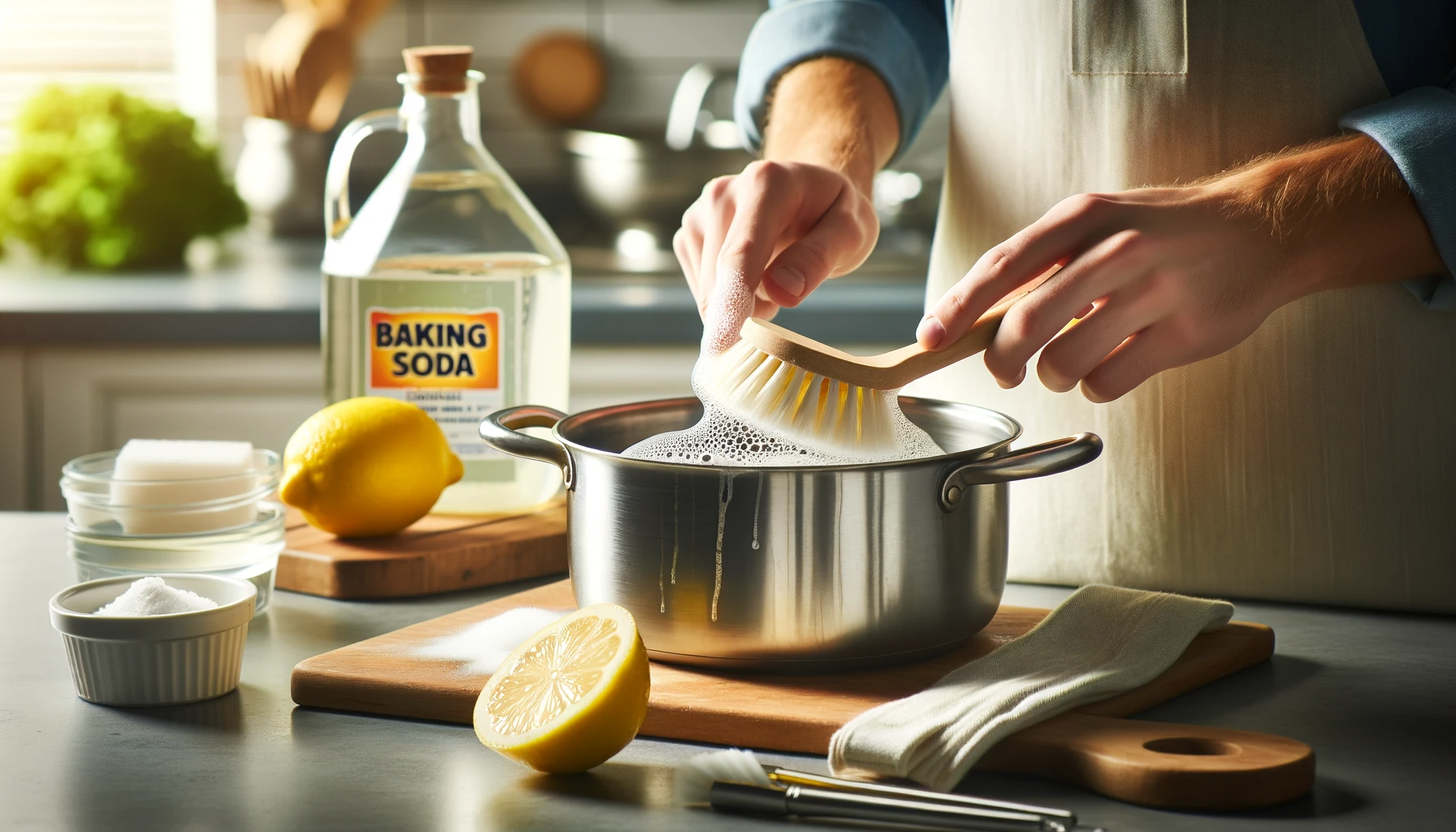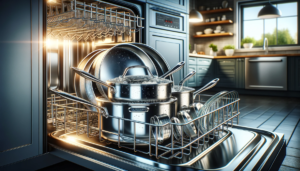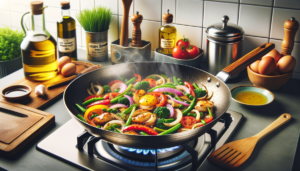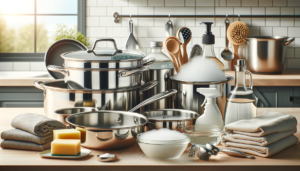Have you noticed dark greasy spots, yellowish discoloration, or brown burnt on stains building up on your stainless steel pots and pans? These annoying heat stains can be stubborn to remove if you don’t act quickly.
This guide covers simple cleaning methods for fresh heat stains as well more involved techniques for tackling baked-on discoloration and mineral scale on stainless steel cookware.
Let’s dive in to causes, DIY treatments, specialty cleaners, prevention tips, and more for removing heat stains from stainless steel pots and pans.
How To Remove Heat Stains From Stainless Steel Cookware?
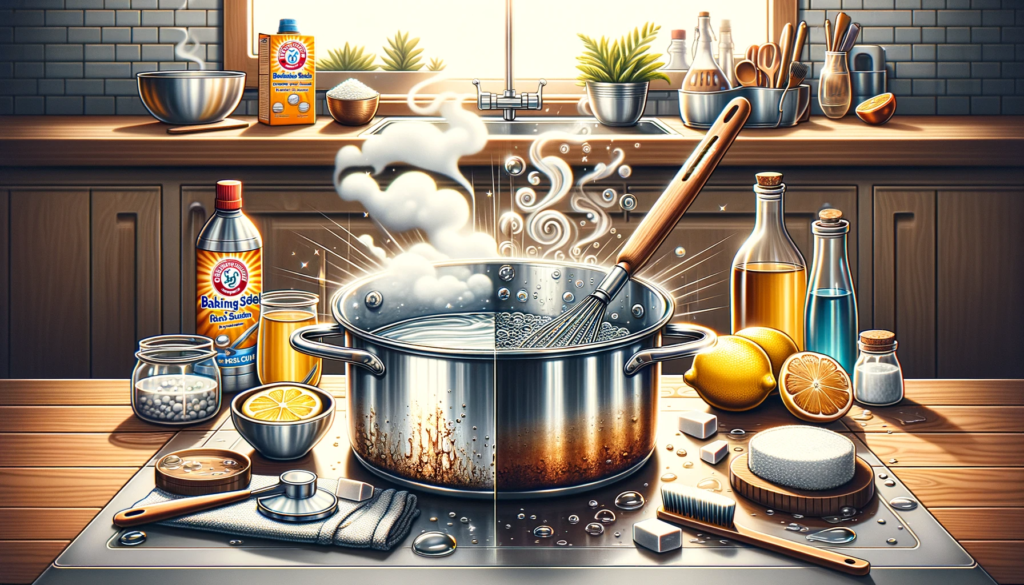
You remove heat stains from stainless steel cookware by making a cleaning paste of baking soda and water or using lemon juice.
Apply the paste to the stains, let sit for 10-20 minutes, then scrub with a soft brush or sponge before rinsing.
For tougher stains, use a specialty cleaner like Barkeepers Friend.
You can also try soaking in vinegar or scrubbing with salt and water.
We’ll explore more stain removal methods in detail below.
What Causes Heat Stains On Stainless Steel Cookware
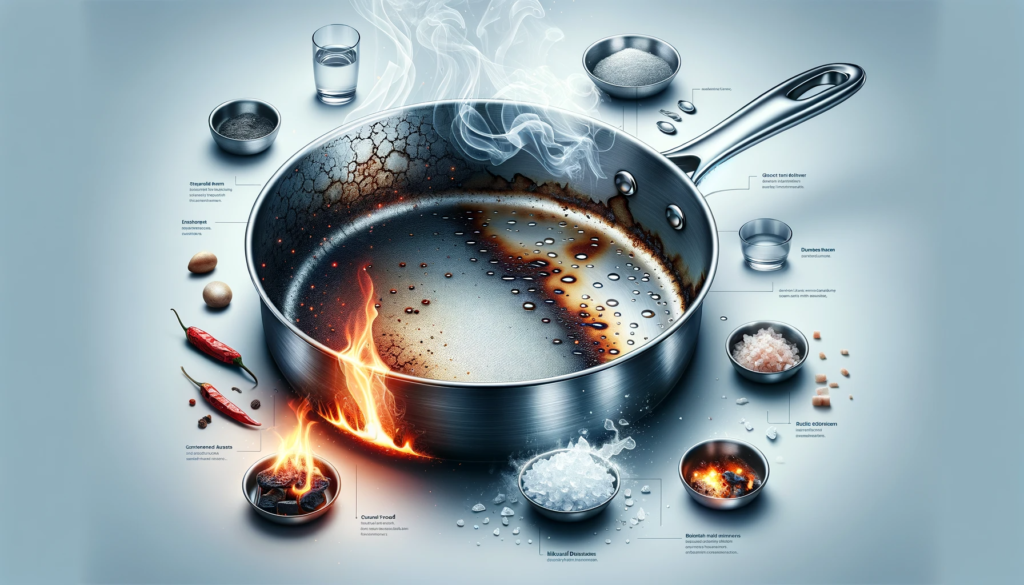
Discoloration and staining of stainless steel pans and pots can occur when the cookware is overheated without any food or liquid inside.
The extreme heat causes the metal itself to start breaking down, essentially burning the interior surface and resulting in burnt on stains and deposits.
Food residue from cooking can also burn onto the surface of stainless steel if it is not properly cleaned afterward.
As food is cooked, grease, sugars, starches and proteins bake onto the metal surface.
If left overnight or not thoroughly scrubbed off, these food soils will carbonize and chemically bond to the pan, leaving stubborn heat stains behind.
Another culprit that leads to staining and discoloration over time is mineral deposits from water.
When water boils away repeatedly in a pan, the minerals left behind such as calcium and magnesium will leave their mark.
Cleaning Methods To Remove Light Heat Stains
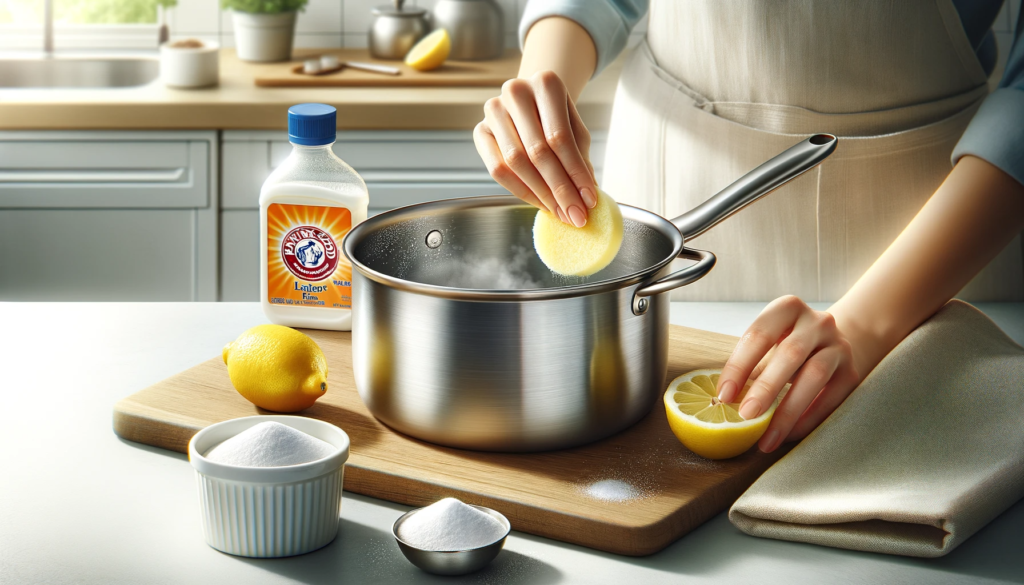
Baking Soda Or Lemon Juice Paste
For light heat stains that have not burnt down into the stainless steel surface, a simple homemade cleaning paste may do the trick.
Make a paste with baking soda and water, applying just enough water so that a thick, viscous paste forms when mixed together.
Alternatively, fresh lemon juice can be substituted for the water when mixing with the baking soda.
Apply thispaste directly to the affected areas of the cookware, ensuring to get down into the grooves and corners of any decorative etchings on the stainless steel.
Allow the paste to sit for approximately 10 to 20 minutes so that the alkaline properties have time to break down the staining.
Use a sponge, cloth or scrubbing brush to then agitate and scrub at the pasted areas to lift and dissolve away the marks.
Rinse thoroughly when finished scrubbing.
Repeat if any lingering stain shadows remain.
The same method can be used with undiluted lemon juice instead of the baking soda paste.
Simply pour fresh lemon juice directly onto the problem areas, let sit for 20 minutes or longer, then scrub and rinse away.
Vinegar Soak
For light heat stains affecting the entire interior surface of a pot or pan, a vinegar soak may lift the discoloration effectively.
Fill the cookware fully with undiluted, white distilled vinegar until all affected areas are submerged.
Allow the pan to soak for 30 minutes to an hour.
The acetic acid in the vinegar will work to dissolve staining residues.
After soaking, empty the vinegar from the pan and scrub stains with a cloth, sponge or nylon bristle brush.
Use elbow grease when scrubbing to lift any stains loosened by the vinegar.
Thoroughly rinse away all vinegar residue afterward.
Repeat the vinegar soak and scrub process if any ghost stains or discoloration remain.
This method works well for hard water mineral stains too.
Dishwasher Detergent
For light heat stains limited to small areas of a stainless steel pot or pan, regular dishwasher detergent can be an effective stain buster.
Apply a small dollop of gel or powder dishwasher detergent directly onto the stained region, making sure to work the detergent thoroughly across the whole affected area.
Allow the detergent to sit for 5 to 10 minutes.
Follow the sitting time by scrubbing vigorously sideways with a damp sponge or scrubbing brush.
The surfactants and degreasing agents in dishwasher formulas are formulated to cut through cooked-on food residue as well as burnt staining.
Thoroughly rinse away detergent residue after scrubbing.
Finish by washing in warm, soapy water to ensure no detergent is left behind.
Removing Stubborn Or Heavy Heat Stains

Barkeepers Friend Cleanser
Barkeepers Friend is a specialty powder cleanser that excels at removing difficult baked-on stains from stainless steel and other cookware.
To use Barkeepers Friend, form a paste by mixing the powder with a small amount of water.
Only add enough water so that a thick paste results that can stick and remain on vertical surface areas.
Use a cleaning cloth or soft scrub brush to apply the textured paste thoroughly to heavily stained areas of the stainless steel cookware, targeting any areas with visible surface discoloration or deposits.
Allow the paste to set for 5 to 10 minutes.
The oxalic acid within Barkeepers Friend will work to lift and dissolve burnt on stains.
After letting it set, scrub vigorously with a sponge or scrub brush to lift stains.
Rinse thoroughly when finished.
Repeat if ghost staining remains.
Salt Scrub
For cookware with extensive heat staining or discoloration, a salt scrub can help scour the stains away.
Pour a generous layer of coarse salt into the bottom of the affected pan or pot.
Kosher salt, sea salt, or rock salt work well.
Cover the salt with just enough hot water to make a wet slurry.
Using a soft cloth, stiff scrubbing brush or plastic mesh scrubber, scrub the salt thoroughly against the surface stains to abrasively lift them away.
The combined friction and dissolving action of the dampened salt can remove even stubborn heat stains without damaging stainless steel’s protective surface layer.
Scrub with the salt slurry for several minutes using elbow grease to ensure stains lift.
When finished, thoroughly rinse away all salt residue.
Repeat as needed for difficult stains.
Electrolysis Stain Removal
For extreme, baked-on heat discoloration that will not budge with other cleaning methods, electrolysis stain removal sometimes does the trick.
This chemical-free process utilizes an electric current, distilled water and sodium carbonate to essentially lift burnt on stains away from the stainless steel surface at the molecular level.
Submerge the affected cookware fully in a non-conductive tub or basin, along with water and a small amount of dissolved sodium carbonate (washing soda / soda ash).
Position a piece of stainless steel metal, such as a butter knife or screwdriver, inside the solution without touching the affected pan.
Connect wires from a 12-volt battery charger (alternatively a solar panel can be used) to the two stainless steel objects, establishing an electric current.
Over 15-90 minutes, the electric current causes the staining molecules to detach and break apart from the cookware item via electrolysis.
Rinse very thoroughly after completed.
Preventing Future Heat Stains
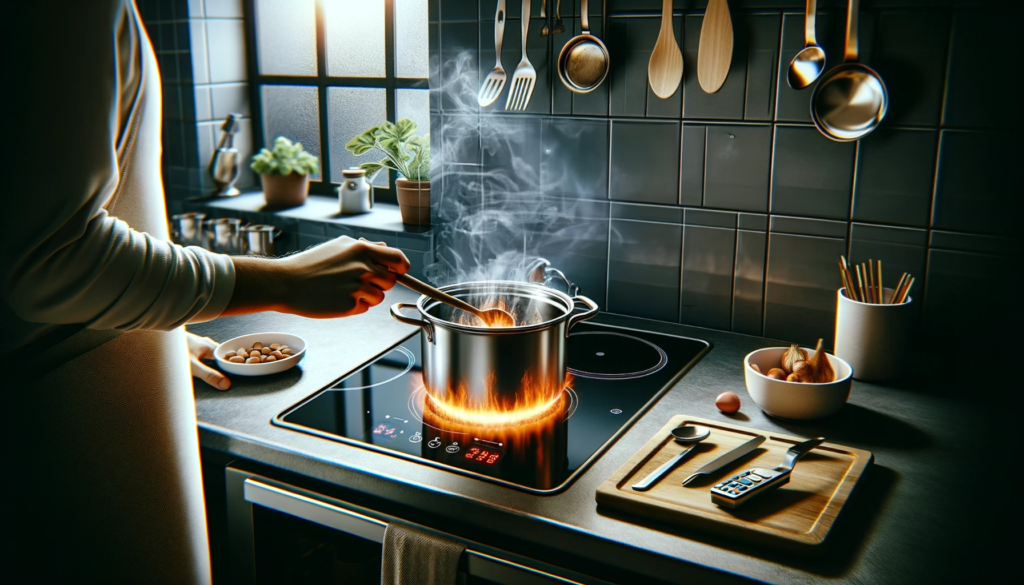
Don’t Overheat Empty Pans
The easiest way to prevent heat stains on stainless steel cookware is to avoid overheating it while empty.
Never turn the stove burner to high heat when cooking with an empty pan or pot.
Overheating can reach the point where the stainless steel itself starts breaking down, essentially burning and staining the surface.
Take care not to leave an empty pan sitting overheat long enough that deterioration occurs.
Only preheat cookware for the minimal time needed to achieve the target cooking temperature.
And never leave empty cookware sitting over high heat while distracted or forgetting about it during multitasking.
Stay vigilant when pans are empty over heat.
Clean Pans Thoroughly After Cooking
Promptly cleaning stainless steel pans and pots after cooking prevents food residues from burning onto the interior surface resulting in heat stains.
Allow cookware to cool to a safe temperature after cooking so that cleaning can be comfortably managed.
Use hot water, dish soap, a soft cloth and gentle scrubbing to remove all visible food residue accumulated during the cooking process.
Pay special attention to any decorative etchings or crevices where food debris tends to collect.
If needed, allow pans to soak briefly to loosen stubborn cooked-on residue.
Adding 1/2 cup baking soda or vinegar to the soak water can boost cleansing power.
Avoid using abrasive scouring pads during cleaning, as these can damage stainless steel over time, breaking down the protective surface layer leading to deterioration.
Remove Mineral Deposits Regularly
To prevent mineral staining over time, regularly remove the mineral deposits left behind from water boiling.
Fill stained pans or pots with water and add 1-2 cups of distilled white vinegar.
Bring the vinegar solution to a gentle simmer for 5-10 minutes to dissolve mineral buildup on the stainless steel surface.
Use a plastic mesh scrubber if needed to gently lift any visibly loosened deposits.
Empty and rinse pans thoroughly after vinegar boiling.
For tea kettles prone to mineral scale, alternate using filtered or distilled water when possible to reduce staining potential long term.
Also consider products made to prevent scale if heavy staining persists.
Avoid Using Abrasive Scouring Pads And Cleansers
Unless absolutely necessary for extreme staining situations, avoid using abrasive scouring pads and cleansers on stainless steel.
Scouring pads, whether styled steel wool or layered plastic, will eventually scratch the protective surface layer on stainless steel resulting in deterioration over time.
Powder cleansers often contain abrasives as well that scratch away at stainless steel.
These microscopic scratches damage the chromium oxide layer that gives stainless steel its staining and corrosion resistance.
Without this protective barrier, the stainless steel underneath becomes vulnerable to staining, pitting and other degradation.
When possible, always use gentle, non-abrasive cleaning methods to maintain the stainless steel surface.
Conclusion
In conclusion, heat stains on stainless steel pots and pans can often be removed with simple homemade pastes, soaks, or scrubbing if caught early on.
For severe baked-on stains, specialty cleansers like Barkeepers Friend or electrolysis may be required.
As long as the protective surface layer is not damaged through abrasion, stained stainless steel cookware can typically be restored close to new looking condition.
Avoiding overheating empty pans, promptly cleaning after cooking, and regularly removing mineral deposits can prevent many stains from forming in the first place.
